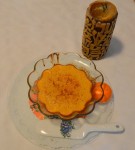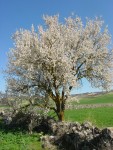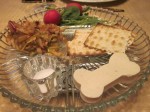A boat of new immigrants arrives in pre-state Israel on Oct. 2, 1947. (photo from the Palmach Archive via PikiWiki Israel)
The Passover seder begins by welcoming anyone who is hungry, an idea that comes straight from the Book of Exodus (23:9), which states, “You shall not oppress a stranger, since you yourselves know the feelings of a stranger, for you also were strangers in the land of Egypt.”
Later in the Torah, Leviticus 19:33 says, “When a stranger resides with you in your land, you shall not do him wrong.” Leviticus 19:34 repeats this refrain, “The stranger who resides with you shall be to you as the native among you, and you shall love him as yourself, for you were aliens in the land of Egypt; I am the Lord your God.”
Over the generations, the Jewish people have been “aliens” more than once. Well-known examples of Jews leaving their perceived homeland include the Jewish exile to Babylonia after the destruction for the first Temple, those who were fortunate enough to escape Nazi persecution for Israel or the United States, expelled Middle Eastern Jews who were moved to Israel after its founding, or residents of the former Soviet Union who left a life of religious oppression.
The immigrant experience is different for everyone, said Aaron Gershowitz, senior director for U.S. programs at the Hebrew Immigrant Aid Society (HIAS). He told this reporter that the challenges of an individual’s journey often depend on the environment they are leaving and the community to which they are relocating.
Take Inge “Irene” Brenner. She escaped from Nazi Germany on Dec. 28, 1938, for Havana, Cuba. From there, she traveled to the United States, arriving to join her husband in April 1939 at age 19. She immediately took up work at a small factory where she steamed hat plumes. Her employer provided her with the required documentation to book passage for her mother, father and sister to the United States. Due to a lack of funds, the family all lived together in a tiny apartment in New York.
“When I left Berlin, I was 19 and completely single-minded, [telling myself] ‘I must get out and save myself and my parents,’” Brenner said. “We just couldn’t have existed anymore. That is what happened to the rest of my family that didn’t get out – all of them were murdered in the gas chambers. There was nothing else I could do but make it. You just had to make it.”
Gershowitz said that “the economics of surviving” often mark the first several years (or longer) of the immigrant experience. It is only after that period that immigrants become more like others – more focused on family life, a career and a future for their children.
Over time, this was the case for Brenner. Once she and her husband could afford to leave the rest of the family and live on their own, they had two daughters who they raised to be American Jews, as opposed to Jewish Americans. Brenner said she wanted to leave her horrible past behind for a new life, which she feels she received “by the grace of God.”
“She was always proud to be Jewish, but it was always extremely hard for her to talk about how she got here,” said Benjamin Kopelman, Brenner’s grandson.

Lev Golinkin, author of a memoir on the immigrant experience titled A Backpack, a Bear and Eight Crates of Vodka, noted the irony that Soviet Jews came to the United States in search of religious freedom, yet many of them choose not to practise Jewish traditions, his family included.
“As soon as we could, we got away from the synagogue and Jewish organizations and melded into the secular American world,” he said.
Golinkin, who arrived in the United States from eastern Ukraine in 1989 at the age of 9, surmised that people turned away from religious observance because it was precisely the Jewish faith that made them targets for persecution in the former Soviet Union. Before escaping, Golinkin was being homeschooled because he had been regularly teased and beaten for his Judaism. Religion, therefore, was nothing to celebrate for him.
“I wanted nothing to do with that. I saw being a Jew as a stigma, a disability,” said Golinkin.
But as he grew up, Golinkin’s opinion changed.
“I think it is interesting that the Israelites stayed in the desert and didn’t start over until that generation had passed away. They needed a clean slate, they needed people whose memories are formed in the new land with the new traditions,” he said.
Read more at jns.org.
Maayan Jaffe is an Overland Park-based freelance writer. Reach her at [email protected] or follow her on Twitter, @MaayanJaffe.








